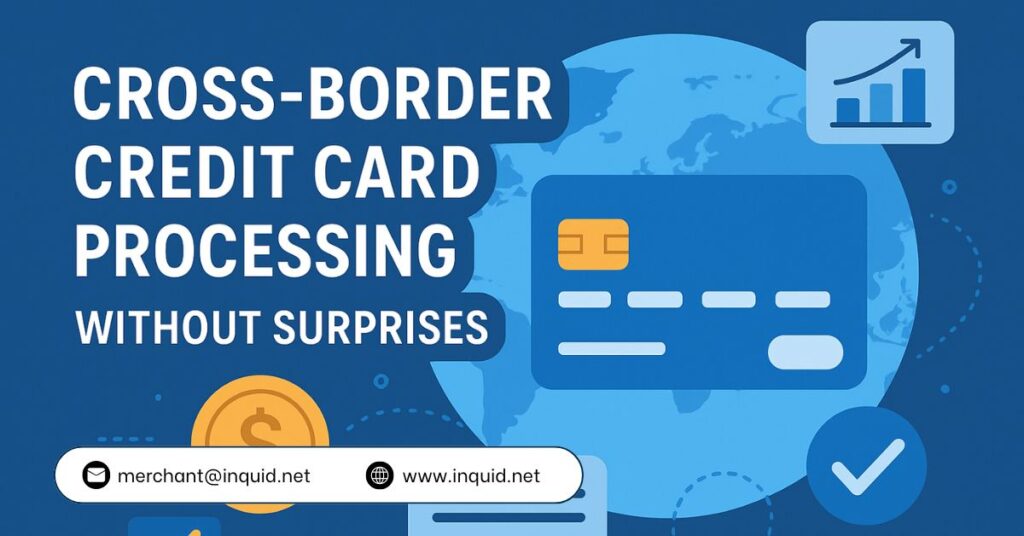
Handling payments from customers in different countries can be rewarding, but it’s rarely straightforward. Exchange rates, extra fees, and regulatory rules often complicate the process. Businesses aiming for smooth operations across borders need to understand how cross-border credit card processing works internationally and how to avoid unexpected setbacks.
Understanding How Cross-Border Credit Card Processing Works
When a customer from another country pays by card, the transaction travels through multiple channels: the merchant’s payment gateway, the acquiring bank, the card network, and finally the issuing bank. Each party may apply fees, currency conversions, or compliance checks before the payment reaches your account.
Choosing the right credit card processing partner matters here. The provider should be able to handle multiple currencies, detect fraud patterns, and manage settlement delays without disrupting your cash flow.
Common Surprises That Hurt International Transactions
Even established businesses run into unexpected issues with cross-border payments. Some of the most common include:
- Foreign transaction fees: Added by issuing banks, these can cut into profits if not factored into pricing.
- Currency conversion costs: Rates may not match market averages, leading to revenue loss over time.
- Longer settlement periods: Some regions take days longer to release funds.
- Chargebacks from international customers: Often harder to dispute due to jurisdiction differences.
- Regulatory restrictions: Countries may impose limits on certain high-risk industries.
Understanding these risks allows you to set realistic timelines and pricing before expanding internationally.
Reducing Declines in Cross-Border Payments
One of the biggest frustrations for merchants is a higher decline rate for foreign card payments. Issuing banks may reject a perfectly valid transaction if it triggers fraud detection filters. This often happens when the payment is flagged as unusual based on location or currency.
Working with a provider that offers instant credit card processing approvals can make a difference. Such systems adapt to regional transaction patterns, increasing the chances of approval without compromising security.
Keeping Processing Costs Under Control
Cross-border transactions often carry higher fees than domestic ones. You might face interchange rates, network fees, acquirer markups, and currency-related costs. Without careful oversight, these charges can pile up.
Comparing options for high-risk credit card processing can help businesses in flagged industries avoid inflated rates. Providers experienced in handling global payments often have negotiated rates with banks and card networks, making them more competitive.
Monitoring and analyzing your credit card processing fees monthly can reveal patterns, such as which countries or currencies cost more to process. Armed with that data, you can adjust your accepted payment methods or set minimum order values for high-cost regions.
Fraud Prevention in International Transactions
Fraud risk increases when payments originate from unfamiliar regions. Criminals often target cross-border channels because it’s harder for merchants to verify buyer identity. This makes fraud detection tools vital, especially for industries already considered high risk.
Advanced verification methods, such as 3D Secure, device fingerprinting, and geolocation checks, help filter out bad transactions while letting legitimate payments through. Businesses should balance fraud prevention with a smooth checkout process, as excessive verification can cause genuine customers to abandon their purchase.
Adapting to Regional Preferences
While credit cards remain popular in many countries, they’re not always the top choice. In some markets, digital wallets, local bank transfers, or cash-on-delivery options outperform card usage. Offering a mix of payment methods based on target regions can help capture more sales and reduce cart abandonment.
However, since this blog focuses on credit card transactions, understanding regional card network dominance (Visa, Mastercard, American Express, local brands) can improve approval rates and customer satisfaction.
FAQs on Cross-Border Credit Card Processing
1. What is cross-border credit card processing?
It’s the process of accepting card payments from customers located in other countries. The payment travels through multiple banks, networks, and currency conversions before reaching the merchant’s account.
2. Why do cross-border payments have higher fees?
They often involve extra costs like currency conversion, international network fees, and higher fraud risk, which increases processing rates.
3. How can I reduce declines for international card transactions?
Using a provider with instant credit card processing approvals can help. Such systems recognize regional transaction patterns and reduce unnecessary rejections.
4. Are chargebacks harder to dispute with international customers?
Yes. Different regulations, time zones, and evidence requirements can make disputes more complex for cross-border transactions.
5. How do I track cross-border processing costs?
Review your credit card processing fees regularly. Analyzing fees by country or currency helps identify costly markets and adjust payment strategies.
